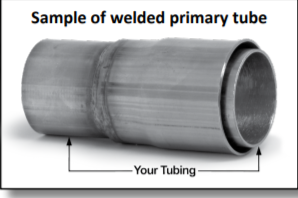okay I found a good
company called SPD Exhaust. They have everything you need in
321ss.
With the engine being an RX8, we have three exhaust ports.
Should I weld the front and back solid to the muffler, and make
the middle one a slip fit for expansion? Or vice-vesa?

- Matt Boiteau
On 2019-12-28
11:03:42 AM, Finn Lassen finn.lassen@verizon.net
<flyrotary@lancaironline.net> wrote:
I did something similar with my
RV-3 13B decades ago. It split open at the welds around
one of the pipes from the manifold into the the big outer
tube. True, it did use individual manifold base plates,
not the connected factory manifold and the big tube was
only 0.035.
Still, I would recommend slip joints on two of the three
pipes, like I added on one of the pipes (cut through and a
surrounding bigger pipe -- missing in picture).

Can't remember why I went from the above to individual
runners into a perforated pipe under the fuselage.
Probably got lured by promise of increased power by tuned
lengths and still uncomfortable by the muffler being
inside the cowling.
Finn
On 12/28/2019 12:10 AM, Matt Boiteau
mattboiteau@gmail.com wrote:
This
is what I'm going to try in a few weeks.
"
Exhaust
valve opens and a pulse of hot gas puffs out through a
short pipe, then tangentially into
a cylindrical canister. Being tangential, the pulse
flattens out and travels helically (rather than bouncing and reverberating
around) along the inside curved wall of the can,
spiraling toward the exit, where it comes out more
uniform in flow and so pretty quiet."
Outer pipe = 321 ss 0.050 thick. Flat plate bent to
a 5" tube
Inner pipe = 321 ss 0.036 thick. 2.5" diameter
(I
might use 302ss 0.065 since I already have it)
From my understanding, the area of the holes
should be double the area of the inner pipe.
- Matt Boiteau